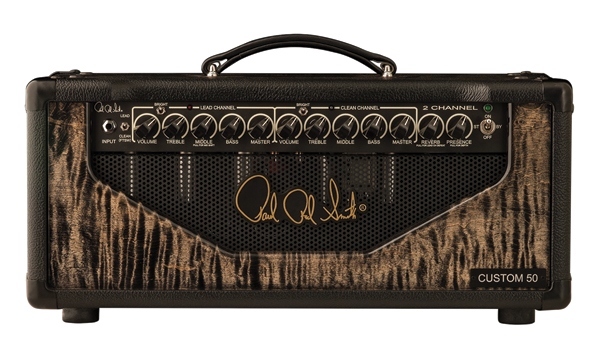2-Channel Custom Amplifier
PRS Guitars, based in Stevensville MD and in business since 1985, has become known over the past nearly three decades—by retailers and players alike—for building some very cool, great-sounding electric, acoustic and bass guitars, as well as boutique-style guitar amplifiers. It’s renowned for its Private Stock guitar department and, in a similar vein, its Custom Amp Design (CAD) program, which has been operating for about three years. Individuals can custom order from any current or past PRS amplifier platform. The company can then customize the amp mechanically, sonically or visually to suit one’s preferences and needs. Another way to approach the program is to purchase one of the company’s CAD model amps: the Sweet 16+, 25th Anniversary, HXDA, “Paul’s Amp,” PRS Blistertone, PRS Dallas and, finally, the 2-Channel Custom. In this article, we’ll zero-in on the 2-Channel Custom, exploring its unique value proposition.
 According to Mike Clark, Amplifier Sales Manager, PRS Guitars, the development of the 2-Channel Custom has been ongoing for a few years, really having its origin with the 2-Channel H. “With that amplifier,” he began, “we wanted to offer a competitively priced two-channel amp that was hand-wired and made in the U.S.A. We wanted to address what we felt the primary weakness of most two-channel amplifiers was: the clean channel.” He continued, “Many two-channel amps do not offer a clean channel with the flexibility of their single-channel counterparts. Generally, they are too clean, with much less harmonic content. We feel like the clean channel is a real strong point of our two-channel amplifiers.”
According to Mike Clark, Amplifier Sales Manager, PRS Guitars, the development of the 2-Channel Custom has been ongoing for a few years, really having its origin with the 2-Channel H. “With that amplifier,” he began, “we wanted to offer a competitively priced two-channel amp that was hand-wired and made in the U.S.A. We wanted to address what we felt the primary weakness of most two-channel amplifiers was: the clean channel.” He continued, “Many two-channel amps do not offer a clean channel with the flexibility of their single-channel counterparts. Generally, they are too clean, with much less harmonic content. We feel like the clean channel is a real strong point of our two-channel amplifiers.”
From there, PRS transitioned into the development of the Custom. Sonically, the amp is almost exactly like the H, but boasting greater flexibility. Features, which we’ll explore below in greater depth, include a solo boost with controls on each channel, mid shift pull switch, deep boost pull switch, presence control, LED indicators on the three-function footswitch (channel, solo boost, reverb), loop bypass when not being used and the ability to disengage the reverb on the lead channel. “These things meet the additional needs of the gigging musician,” Clark declared. (It should be noted that some of these features were actually added to H amplifiers through the CAD program, prior to the Custom’s introduction.) The 2-Channel Custom is available as a 50-watt head, 100-watt head or a 50-watt 1×12 closed back combo (with other wattages potentially available through a special CAD order). “We also offer speaker cabinets in 112, 212, 410 or 412 configurations,” Clark added.
To dig a bit deeper into the technology behind the Custom, and the features offered, it uses 6L6s or EL 34 power tubes, with 6L6s as the standard. The amps boast master and gain controls and three-way EQ for both channels. This delivers the maximum amount of control over each channel. The master volume and gain controls allow users to create their sound at any volume. Solo boost allows players to have a pre-set boost for each channel that will increase their overall volume for a solo. There’s also a control for each channel, allowing flexibility from each. An FX loop provides the ability to run time-based effects cleanly and seamlessly after the pre amp section of the amplifier.
Another key feature, which we alluded to earlier, centers on mid shift and deep boost. These push/pull knobs allow extra tone-shaping capabilities, creating a more flexible platform. Finally, we come to hand wiring. This is a detailed, handmade platform in which all the components are hand stuffed in the boards and soldered by hand, as opposed to solder baths used by many manufacturers. “This creates a quality product with attention to detail designed to last,” remarked Clark. “For example, each amp is hand-tuned to minimize issues like microphonics and background noise.”
These versatile and articulate amplifiers are well suited for alternate tunings, although, according to Clark, the 100-watt version is generally preferable for this. He explained, “Things like Drop C tuning require increased headroom to maintain note definition. These tunings put extra demands on both the pre-amp and power sections of a tube amp. More power—increased headroom—works much better in these applications. We’ve paid careful attention to the characteristics of the low-mids and lows of the amp to maintain the ‘tight,’ responsive, but full-sounding, tone and feel that guitarists using alternate tunings generally require.”
As one would imagine, the market for a product like this is quite broad, a point Clark underscored by saying, “We designed the Custom to meet the needs of the gigging musician and the hobbyist who wants a feature-packed amplifier suitable for classic rock, ’80s metal, country, blues and indie music, all in a great-looking package with top-quality components at a mid-level price point.” He also mentioned very positive feedback received this past January at the NAMM show, at which the Custom made its debut. “We have also gotten a lot of feedback from artists, such as Dave Weiner who plays with Steve Vai. He’s using our 100-watt H on tour,” he added. Clark also remarked about the huge role PRS’ artists play in the…


